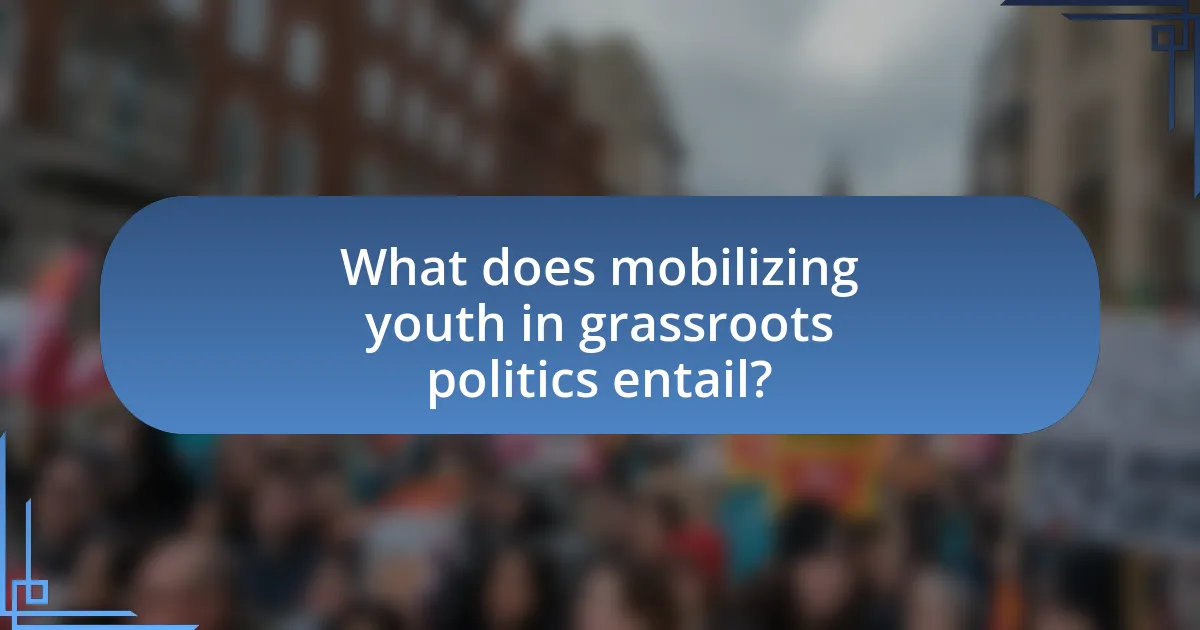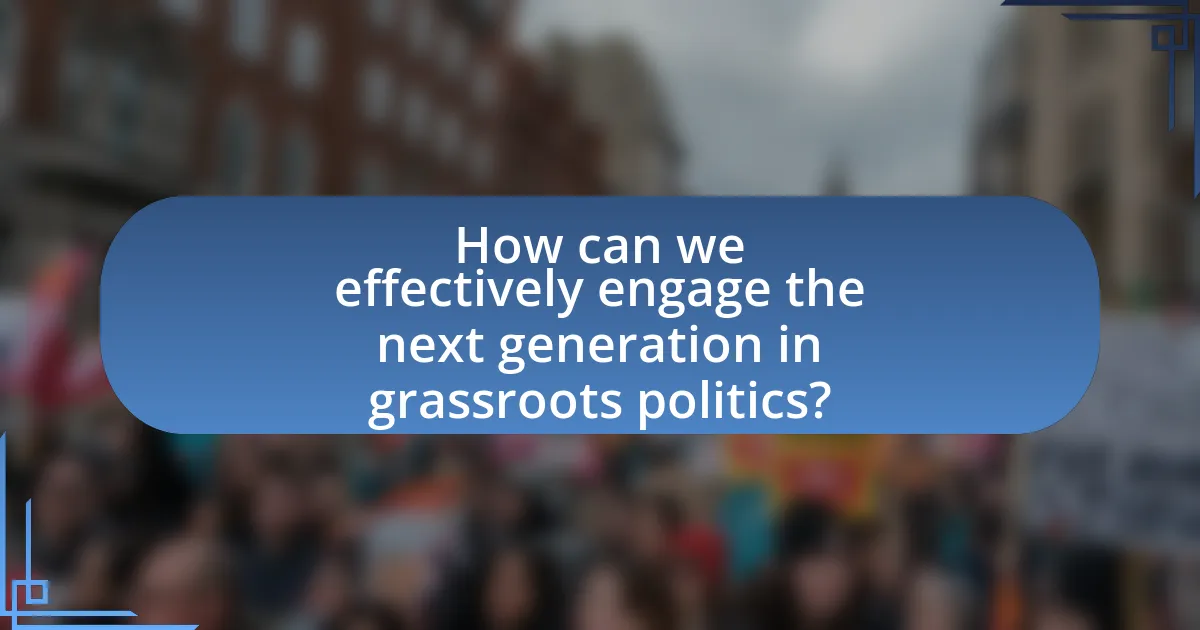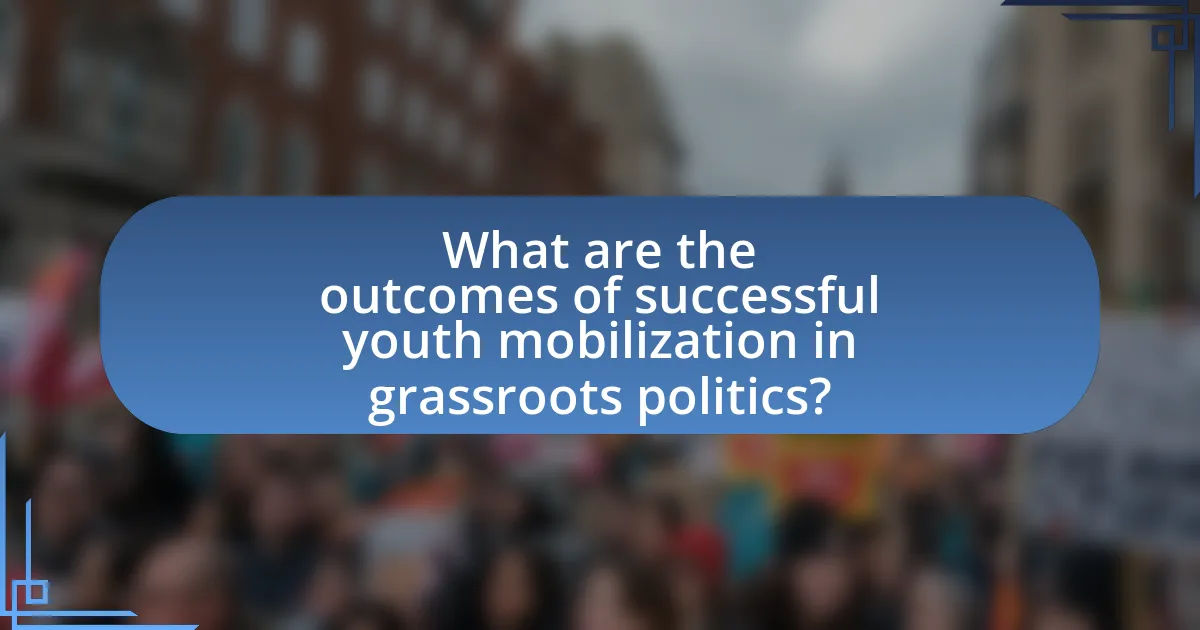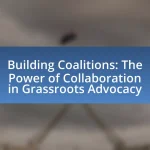Mobilizing youth in grassroots politics involves engaging young individuals in local political processes to influence decision-making and advocate for community issues. This article explores the significance of youth engagement, highlighting its historical impact on movements such as the Civil Rights Movement and the anti-apartheid struggle. It discusses the challenges faced in mobilizing youth, including apathy and socioeconomic barriers, while emphasizing the role of technology and educational institutions in fostering political awareness. Additionally, the article outlines effective strategies for sustaining youth interest in grassroots politics and the long-term benefits of increased youth participation in shaping future political landscapes.

What does mobilizing youth in grassroots politics entail?
Mobilizing youth in grassroots politics entails actively engaging young individuals in local political processes to influence decision-making and advocate for community issues. This engagement often includes organizing events, facilitating discussions, and providing training on political advocacy, which empowers youth to voice their concerns and participate in civic activities. Research indicates that youth involvement in grassroots movements can lead to increased voter turnout and greater representation of young people’s interests in policy-making, as seen in movements like the March for Our Lives, which successfully mobilized young activists to address gun control legislation.
Why is youth engagement crucial in grassroots politics?
Youth engagement is crucial in grassroots politics because it fosters a sense of ownership and responsibility among young individuals regarding their communities and governance. Engaging youth allows for the infusion of fresh perspectives and innovative ideas that can address contemporary issues effectively. According to a study by the Center for Information & Research on Civic Learning and Engagement, youth participation in political processes leads to higher rates of civic engagement in adulthood, demonstrating the long-term benefits of early involvement. Furthermore, youth are often at the forefront of social movements, as seen in recent climate change activism, highlighting their capacity to mobilize and influence public policy.
What historical examples highlight the impact of youth in political movements?
Youth have significantly impacted political movements throughout history, with notable examples including the Civil Rights Movement in the United States and the anti-apartheid struggle in South Africa. During the Civil Rights Movement, young activists, such as those involved in the Student Nonviolent Coordinating Committee (SNCC), played crucial roles in organizing protests, sit-ins, and voter registration drives, which were pivotal in challenging racial segregation and discrimination. Their efforts contributed to landmark legislation, including the Civil Rights Act of 1964 and the Voting Rights Act of 1965.
In South Africa, youth activism was instrumental in the fight against apartheid, particularly during the Soweto Uprising in 1976, where thousands of students protested against the imposition of Afrikaans as the medium of instruction in schools. This uprising galvanized international attention and support for the anti-apartheid movement, ultimately leading to the dismantling of apartheid and the establishment of a democratic South Africa in the early 1990s. These examples illustrate how youth have historically mobilized to effect significant political change.
How does youth engagement influence policy changes?
Youth engagement significantly influences policy changes by amplifying the voices of younger demographics in political discourse. When young people actively participate in advocacy, they bring fresh perspectives and innovative solutions to pressing issues, which can shift public opinion and prompt policymakers to respond. For instance, movements like the March for Our Lives, initiated by students after the Parkland shooting, successfully lobbied for gun control measures, demonstrating how organized youth activism can lead to tangible legislative outcomes. Additionally, research from the Harvard Kennedy School indicates that youth-led initiatives often mobilize broader community support, further increasing the pressure on policymakers to enact change.
What are the key challenges faced in mobilizing youth?
The key challenges faced in mobilizing youth include apathy, lack of access to resources, and ineffective communication strategies. Apathy among young people often stems from feelings of disenfranchisement and skepticism towards political systems, which can hinder their engagement. Additionally, many youth lack access to essential resources such as information, mentorship, and funding, which are crucial for participation in grassroots movements. Ineffective communication strategies, including the failure to utilize platforms that resonate with younger demographics, further complicate efforts to mobilize this group. These challenges are supported by studies indicating that youth engagement in politics is significantly influenced by their perception of relevance and accessibility to political processes.
How do socioeconomic factors affect youth participation?
Socioeconomic factors significantly influence youth participation by shaping access to resources, opportunities, and social networks. For instance, youth from lower socioeconomic backgrounds often face barriers such as limited access to education, financial constraints, and fewer extracurricular opportunities, which can hinder their engagement in political and community activities. Research indicates that youth from affluent families are more likely to participate in civic activities due to greater access to information, mentorship, and supportive environments. A study by the Pew Research Center found that socioeconomic status correlates with civic engagement levels, highlighting that 60% of youth from higher-income families reported participating in community service compared to only 30% from lower-income families. This disparity underscores the critical role socioeconomic factors play in determining the extent and nature of youth involvement in grassroots politics.
What role does technology play in engaging young people?
Technology plays a crucial role in engaging young people by facilitating communication, providing access to information, and enabling participation in social and political movements. Digital platforms, such as social media, allow youth to connect with peers, share ideas, and mobilize for causes they care about, significantly increasing their involvement in grassroots politics. For instance, a study by the Pew Research Center found that 72% of teens use social media, which serves as a vital tool for organizing events and raising awareness about issues like climate change and social justice. This connectivity empowers young individuals to influence public discourse and participate actively in civic engagement.

How can we effectively engage the next generation in grassroots politics?
To effectively engage the next generation in grassroots politics, organizations must leverage digital platforms and social media to create interactive and accessible political discussions. Research indicates that 90% of young people use social media, making it a vital tool for outreach and engagement. By utilizing platforms like Instagram, TikTok, and Twitter, grassroots movements can share information, mobilize support, and encourage participation in local initiatives. Additionally, incorporating educational programs that focus on civic engagement and political literacy in schools can empower youth to understand and participate in grassroots efforts, fostering a sense of responsibility and community involvement.
What strategies are most effective for mobilizing youth?
Effective strategies for mobilizing youth include leveraging social media platforms, fostering peer-to-peer engagement, and creating inclusive spaces for dialogue. Social media platforms like Instagram and TikTok have proven to be powerful tools, as they allow for rapid information dissemination and community building among young people. Research indicates that 71% of young people are more likely to engage in activism when they see their peers participating, highlighting the importance of peer-to-peer engagement. Additionally, creating inclusive spaces for dialogue, such as youth forums and workshops, encourages participation and empowers young individuals to voice their opinions and concerns. These strategies collectively enhance youth mobilization by utilizing their preferred communication channels and fostering a sense of community and belonging.
How can social media be leveraged for political engagement?
Social media can be leveraged for political engagement by facilitating direct communication between politicians and constituents, enabling grassroots movements, and amplifying diverse voices. Platforms like Twitter and Facebook allow political figures to share their messages instantly, while also providing a space for citizens to express their opinions and mobilize support for causes. For instance, the 2011 Arab Spring demonstrated how social media could organize protests and disseminate information rapidly, leading to significant political change. Additionally, studies show that young voters are more likely to engage with political content on social media, making it a crucial tool for mobilizing the next generation in grassroots politics.
What community-based initiatives have proven successful?
Successful community-based initiatives include youth-led organizations that focus on civic engagement and social justice. For example, the “Youth Organizing Collaborative” in California has effectively mobilized young people to advocate for policy changes, resulting in increased voter registration among youth by 25% in the targeted areas. Additionally, the “Dreamers’ Movement” has successfully united undocumented youth to push for immigration reform, leading to the introduction of the Deferred Action for Childhood Arrivals (DACA) program in 2012. These initiatives demonstrate the power of grassroots organizing in influencing political outcomes and engaging the next generation in civic participation.
What role do educational institutions play in youth mobilization?
Educational institutions play a crucial role in youth mobilization by providing a platform for civic engagement and fostering critical thinking. They facilitate discussions on social issues, encourage participation in community service, and promote awareness of political processes. For instance, research from the National Youth Leadership Council indicates that students involved in service-learning programs are more likely to engage in civic activities, demonstrating the effectiveness of educational settings in mobilizing youth. Additionally, schools and universities often serve as hubs for organizing events, campaigns, and movements, thereby empowering students to take action on issues that matter to them.
How can schools and universities foster political awareness?
Schools and universities can foster political awareness by integrating civic education into their curricula and promoting active participation in political processes. Research indicates that students who engage in discussions about current events and political issues are more likely to develop informed opinions and participate in civic activities. For instance, a study by the Center for Information and Research on Civic Learning and Engagement found that high school students who took civics courses were significantly more likely to vote in elections compared to those who did not. Additionally, institutions can host debates, workshops, and forums that encourage students to explore diverse political perspectives, thereby enhancing their understanding of the political landscape.
What programs can be implemented to encourage civic participation?
Programs that can be implemented to encourage civic participation include youth leadership initiatives, community service projects, and civic education workshops. Youth leadership initiatives empower young individuals by providing them with skills and opportunities to engage in local governance, such as programs like the Youth Council in various cities, which allows participants to voice their opinions on community issues. Community service projects foster a sense of responsibility and connection to the community, evidenced by programs like AmeriCorps, which mobilizes thousands of young people to serve in various capacities. Civic education workshops, such as those offered by organizations like the Center for Civic Education, teach young people about their rights and responsibilities, enhancing their understanding of the democratic process and encouraging active participation in civic life.

What are the outcomes of successful youth mobilization in grassroots politics?
Successful youth mobilization in grassroots politics leads to increased political participation, enhanced representation of youth interests, and the fostering of civic engagement. When young people mobilize effectively, they often influence policy decisions that reflect their needs and priorities, as evidenced by movements like the March for Our Lives, which successfully advocated for gun control reforms in the United States. Additionally, studies show that youth-led initiatives can drive higher voter turnout among their peers, as seen in the 2018 midterm elections where youth turnout increased significantly compared to previous years. This mobilization not only empowers young individuals but also strengthens democratic processes by ensuring diverse voices are heard in political discourse.
How does youth involvement shape future political landscapes?
Youth involvement shapes future political landscapes by introducing fresh perspectives and driving progressive change. Engaged young individuals often advocate for issues such as climate action, social justice, and equality, influencing policy agendas and electoral outcomes. For instance, the 2018 midterm elections in the United States saw a significant increase in youth voter turnout, with a 50% rise compared to previous years, demonstrating their impact on political engagement and decision-making. This trend indicates that as youth continue to mobilize, they will increasingly dictate the priorities of political parties and shape legislative frameworks, ultimately transforming governance to reflect their values and concerns.
What long-term benefits arise from increased youth participation?
Increased youth participation leads to enhanced civic engagement and stronger democratic processes. When young people actively participate in politics, they develop a sense of responsibility and ownership over societal issues, which fosters long-term commitment to civic duties. Research indicates that youth involvement in grassroots movements correlates with higher voter turnout rates in later years, as evidenced by studies showing that individuals who engage in political activities during their youth are more likely to continue participating as adults. Furthermore, increased youth participation contributes to diverse perspectives in decision-making, resulting in policies that better reflect the needs of the entire population. This diversity is crucial for creating inclusive communities and addressing complex social challenges effectively.
How can youth-led initiatives influence local governance?
Youth-led initiatives can influence local governance by actively engaging young people in decision-making processes and advocating for policies that reflect their needs and priorities. These initiatives often mobilize youth to participate in local councils, community meetings, and advocacy campaigns, thereby increasing their visibility and voice in governance. For instance, research from the United Nations indicates that youth participation in governance can lead to more inclusive policies and improved community outcomes, as young people bring fresh perspectives and innovative solutions to local issues. Additionally, successful youth-led initiatives, such as the Youth Climate Strike, have demonstrated the power of collective action in shaping local policies on environmental sustainability, showcasing how organized youth efforts can lead to tangible changes in governance.
What best practices can be adopted for ongoing youth engagement?
To ensure ongoing youth engagement, organizations should adopt practices such as creating inclusive platforms for dialogue, utilizing social media effectively, and providing opportunities for leadership development. Inclusive platforms allow youth to express their opinions and feel valued, which fosters a sense of belonging and commitment. Effective use of social media can reach a broader audience and facilitate real-time communication, making it easier for young people to engage with issues that matter to them. Additionally, providing leadership development opportunities equips youth with the skills and confidence needed to take active roles in grassroots politics. Research indicates that youth who participate in leadership programs are more likely to remain engaged in civic activities, as evidenced by a study from the National Youth Leadership Council, which found that 85% of participants reported increased civic engagement after completing such programs.
How can organizations sustain youth interest in grassroots politics?
Organizations can sustain youth interest in grassroots politics by actively involving them in decision-making processes and providing platforms for their voices. Engaging youth through mentorship programs, workshops, and community projects fosters a sense of ownership and relevance in political issues. Research indicates that youth participation in civic activities increases when they perceive their contributions as impactful; for instance, a study by the Center for Information & Research on Civic Learning and Engagement found that young people who engage in community service are more likely to vote and participate in political discussions. By creating inclusive environments that prioritize youth perspectives, organizations can maintain sustained interest and active participation in grassroots politics.
What resources are available to support youth political initiatives?
Various resources are available to support youth political initiatives, including grants, mentorship programs, and online platforms. Organizations such as the Youth Engagement Fund provide financial support specifically aimed at youth-led projects, while initiatives like the Young Leaders Program offer mentorship and training to empower young activists. Additionally, digital platforms such as Change.org and social media channels facilitate outreach and mobilization, enabling youth to organize campaigns and connect with like-minded individuals. These resources collectively enhance the capacity of young people to engage in political processes and advocate for their causes effectively.


